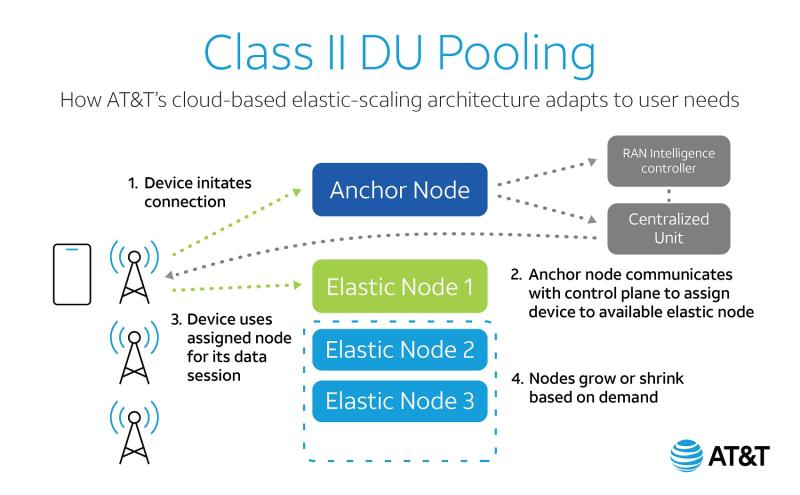AT&T and Intel developed advanced RAN pooling technology that, if it works as intended, could lead to more efficient, resilient and green 5G networks.
It all has to do with elasticity in the Radio Access Network (RAN). An early supporter of open RAN, AT&T points to progress it’s made with Intel to “elasticize” the RAN. In fact, they’ve developed new cutting-edge technology designed to deliver “unprecedented” levels of elasticity in the RAN, according to the operator.
In this case, elastic scaling refers to the ability to use only as much computing hardware as needed at any given time, growing or shrinking the servers for tasks as the demand changes.
“Elastic scaling allows the Internet services we know and love to remain efficient and eco-friendly,” according to a blog post by AT&T’s Gordon Mansfield, VP Mobility Access & Architecture. “By vacating unneeded servers constantly, servers that usually consume a lot of power can now be recycled for other tasks and put to sleep to save energy – all while substantially reducing the number of servers and equipment needed.”
AT&T points out that it’s been on a path to virtualization of its mobile core since 2014. As of 2020, it virtualized more than 75% of its network functions. However, that doesn’t include the RAN, which involves a “completely different set” of challenges to tackle. That’s where it’s innovation with Intel comes in.
Pooling resources
AT&T developed something it calls DU pooling, which provides the most value in Centralized RAN (C-RAN) network deployments where RAN baseband equipment from many cell sites are “pooled together” into a “cloud” of general purpose processors in far edge data central offices, according to Mansfield.
RELATED: For AT&T, more C-RAN is in the clouds
“Through an advanced form of DU pooling called Class II pooling, a single 5G radio can now distribute the baseband processing for each user device in the cell across multiple servers,” he wrote.
“This means that your video conference stream’s packets can be processed by a different baseband server than your rideshare driver’s navigation application data even though you are both connected to the same radio and sharing the same airwaves,” Mansfield explained. “It gives unprecedented elasticity and flexibility to the network to distribute (and redistribute) traffic instantly. If a baseband server becomes overloaded or fails, all impacted user sessions can be moved to a different server without any disruption to customers. And when traffic levels fall, the RAN can consolidate user sessions into fewer servers, putting the unused servers to sleep for even greater efficiency in operating the RAN.”

According to Mansfield’s blog, DU pooling technology was made possible by combining AT&T’s knowledge of open RAN technologies with Intel’s expertise in general purpose processors and software-based RAN (through its FlexRAN software stack running on Intel 3rd generation Xeon Scalable processors.)
Looking ahead, AT&T is working with its RAN suppliers to incorporate DU pooling technology into commercial RAN software products that can be deployed on its 5G network.
Mansfield suggested AT&T and Intel will share their technology with the wider wireless community, presumably through a group like the O-RAN Alliance, of which AT&T was a co-founder.
“We are optimistic that the technology will allow AT&T to provide our customers with an even more reliable and higher performing network while helping us to meet our commitment of a carbon neutral network by 2035,” he wrote. “Eventually, this technology could be made available to all operators so the entire industry can benefit.”